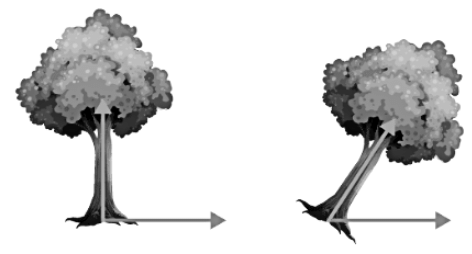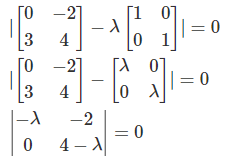Eigen Values & Eigen Vectors | Engineering Mathematics - Engineering Mathematics PDF Download
Definition
- Eigenvalues are a special set of scalars associated with the system of linear equations.
- It is mostly used in matrix equations.
- ‘Eigen’ is a German word that means ‘proper’ or ‘characteristic’.
- Therefore, the term eigenvalue can be termed as characteristic value, characteristic root, proper values or latent roots as well.
- In simple words, the eigenvalue is a scalar that is used to transform the eigenvector.
The basic equation is
Ax = λx
- The number or scalar value “λ” is an eigenvalue of A.
- In Mathematics, an eigenvector corresponds to the real non-zero eigenvalues, which point in the direction stretched by the transformation, whereas an eigenvalue is considered as a factor by which it is stretched.
- In case if the eigenvalue is negative, the direction of the transformation is negative.
- For every real matrix, there is an eigenvalue. Sometimes it might be complex.
- The existence of the eigenvalue for complex matrices is equal to the fundamental theorem of algebra.
What are EigenVectors?
- Eigenvectors are the vectors (non-zero) that do not change direction when any linear transformation is applied.
- It changes by only a scalar factor.
- In brief, we can say, if A is a linear transformation from a vector space V and x is a vector in V, which is not a zero vector, then v is an eigenvector of A if A(X) is a scalar multiple of x.
An Eigenspace of vector x consists of a set of all eigenvectors with the equivalent eigenvalue, collectively with the zero vector. Though the zero vector is not an eigenvector.
Let us say A is an “n × n” matrix and λ is an eigenvalue of matrix A, then x, a non-zero vector, is called an eigenvector if it satisfies the given expression below;
Ax = λx
x is an eigenvector of A corresponding to eigenvalue, λ.
Note:
There could be infinitely many Eigenvectors, corresponding to one eigenvalue.
For distinct eigenvalues, the eigenvectors are linearly dependent.
Eigenvalues of a Square Matrix
- Suppose, A×n is a square matrix, then [A - λI] is called an Eigen or characteristic matrix, which is an indefinite or undefined scalar.
- Where determinant of Eigen matrix can be written as |A - λI| ,and |A - λI| = 0 is the Eigen equation or characteristic equation, where “I” is the identity matrix.
- The roots of an Eigen matrix are called Eigen roots.
- Eigenvalues of a triangular matrix and diagonal matrix are equivalent to the elements on the principal diagonals.
- But eigenvalues of the scalar matrix are the scalar only.
Properties of Eigenvalues
- Eigenvectors with Distinct Eigenvalues are Linearly Independent
- Singular Matrices have Zero Eigenvalues
- If A is a square matrix, then λ = 0 is not an eigenvalue of A
- For a scalar multiple of a matrix: If A is a square matrix and λ is an eigenvalue of A. Then, aλ is an eigenvalue of aA.
- For Matrix powers: If A is square matrix and λ is an eigenvalue of A and n ≥ 0 is an integer, then λn is an eigenvalue of An.
- For polynomials of matrix: If A is a square matrix, λ is an eigenvalue of A and p(x) is a polynomial in variable x, then p(λ) is the eigenvalue of matrix p(A).
- Inverse Matrix: If A is a square matrix, λ is an eigenvalue of A, then λ-1 is an eigenvalue of A-1
- Transpose matrix: If A is a square matrix, λ is an eigenvalue of A, then λ is an eigenvalue of At
EigenValue Example
In this shear mapping, the blue arrow changes direction, whereas the pink arrow does not. Here, the pink arrow is an eigenvector because it does not change direction. Also, the length of this arrow is not changed; its eigenvalue is 1.

Eigenvalues of 2 x 2 Matrix
Let us have a look at the example given below to learn how to find the eigenvalues of a 2 x 2 matrix.
Find the eigenvalues of the 2 x 2 matrix
Given,
Using the characteristic equation,
Let
be the 2 x 2 identity matrix.
|A – λI| = 0
-λ(4 – λ) – (-2)(0) = 0
-4λ + λ2 = 0
λ(λ – 4) = 0
λ = 0 or λ – 4 = 0
Thus, λ = 0 or λ = 4
Hence, the two eigenvalues of the given matrix are λ = 0 and λ = 4.
Go through the following problem to find the Eigenvalue of 3 x 3 matrix.
Eigenspace
- We define the eigenspace of a matrix as the set of all the eigenvectors of the matrix.
- All the vectors in the eigenspace are linearly independent of each other.
- To find the eigenspace of the matrix we have to follow the following steps:
Step 1: Find all the eigenvalues of the given square matrix.
Step 2: For each eigenvalue find the corresponding eigenvector.
Step 3: Take the set of all the eigenvectors (say A). The resultant set so formed is called the Eigenspace of the following vector.
Diagonalize Matrix Using Eigenvalues and Eigenvectors
- Eigenvalues and Eigenvectors are used to find diagonal matrices.
- A diagonal matrix is a matrix which can be written as A = XDX-1 where,
- D is the matrix which is formed by replacing the 1’s in the identity matrix with eigenvalues.
- X is the matrix formed by eigenvectors.
- We can understand the concept of a diagonal matrix by taking the following example.
Example: Diagonalize the matrix A =
Solution: We have already solved for the eigenvalues and the eigenvectors of the A =
The eigenvalues of the A are λ = 0, λ = 0, and λ = -8
The eigenvectors of A are
Thus, D =
, X =
We can easily find the inverse of X as, X-1 =
|
65 videos|129 docs|94 tests
|
FAQs on Eigen Values & Eigen Vectors - Engineering Mathematics - Engineering Mathematics
| 1. What are eigenvalues and eigenvectors? |  |
| 2. How do eigenvalues and eigenvectors relate to matrices? |  |
| 3. How can eigenvalues and eigenvectors be calculated? |  |
| 4. What are the applications of eigenvalues and eigenvectors? |  |
| 5. Can a matrix have multiple eigenvalues and eigenvectors? |  |
























